Human–Computer Communication Using Recognition and Synthesis of Facial Expression
- DOI
- 10.2991/jrnal.k.210521.003How to use a DOI?
- Keywords
- Emotion; facial expression recognition; infrared-ray image; facial expression synthesis; personified agent
- Abstract
To develop a complex computer system such as a robot that can communicate smoothly with humans, it is necessary to equip the system with a function for both understanding human emotions and expressing emotional signals. From both perspectives, facial expression is a promising research area. In our research, we have explored both aspects of facial expression using infrared-ray images and visible-ray images and have developed a personified agent for expressing emotional signals to humans. A human–computer–human communication system using facial expression analysis and a music recommendation system using a personified agent with facial expression synthesis are reported in this paper.
- Copyright
- © 2021 The Author. Published by Atlantis Press B.V.
- Open Access
- This is an open access article distributed under the CC BY-NC 4.0 license (http://creativecommons.org/licenses/by-nc/4.0/).
1. INTRODUCTION
The goal of our study is to present a paradigm whereby a complex computer system such as a robot can cooperate smoothly with humans. To do this, the computer system must have the ability to communicate with humans using some form(s) of information transmission. Such a system must be equipped with a function for both understanding human emotions and expressing emotional signals to its human counterparts. In this regard, facial expression is a promising target for research. Accordingly, we have been investigating both aspects of facial expression.
In this paper, we describe the challenges of reaching our goal. The remainder of the paper is organized as follows: Section 2 summarizes our studies on facial expression recognition; Section 3 briefly describes our studies on human–computer–human communication via the Internet; Section 4 outlines our studies on human–computer communication; Section 5 discusses our work on integration with speech; Section 6 concludes the paper.
2. FACIAL EXPRESSION RECOGNITION
2.1. Infrared-ray Image Utilization
We have developed a method for recognizing facial expressions using thermal image processing [1]. In this study, infrared-ray was used. Figure 1 shows the influence of lighting at night on a facial image using both visible-ray (Figure 1a and 1c) and infrared-ray (Figure 1b and 1d). As is evident in the figure, the visible-ray image is strongly influenced by lighting conditions, while the thermal image is unaffected. With our method, neutral, happy, surprised, and sad facial expressions were recognized with 90% accuracy [1]. Figure 2 shows examples.
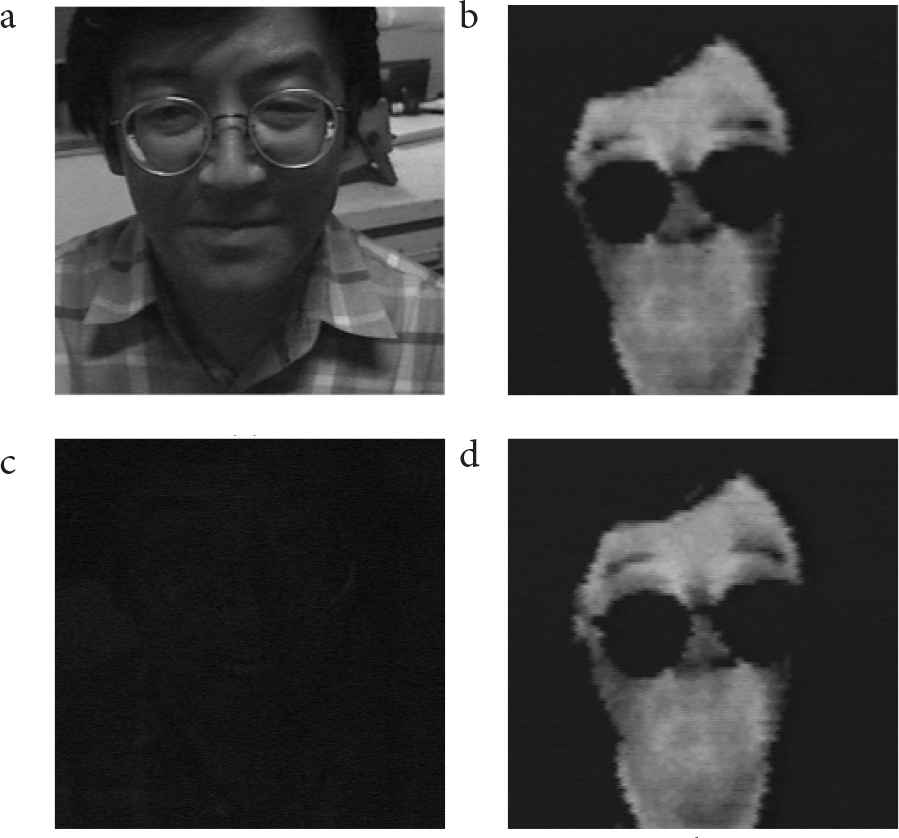
Examples of face-image at night; (a) visible-ray image with lighting, (b) infrared-ray image with lighting, (c) visible-ray image without lighting, (d) infrared-ray image without lighting [1].
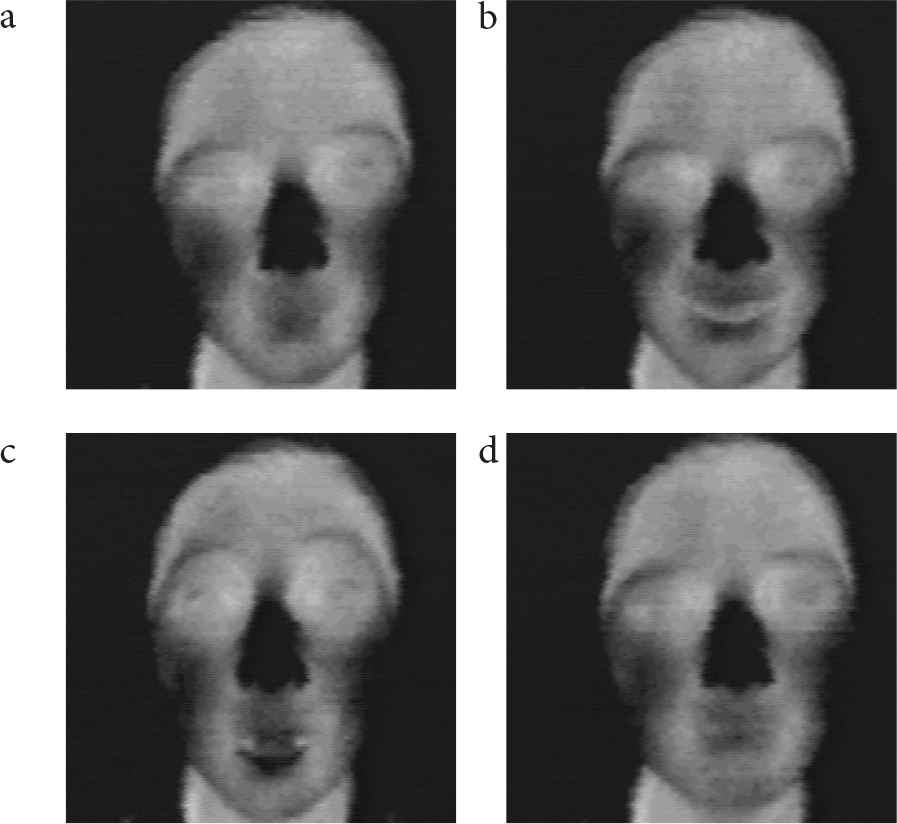
Examples of facial expressions; (a) neutral, (b) happy, (c) surprised, (d) sad [1].
3. HUMAN–COMPUTER–HUMAN COMMUNICATION
Social Network Services (SNSs) have become extremely popular as communication tools on the Internet. However, while it is possible to post a message, a static image, or a moving image on a platform such as Twitter, it is difficult to communicate the actual emotions felt when writing a message or posting an image. We believe that a support system is needed to facilitate smoother communication between humans in their use of SNSs. Not having immediate and direct contact with one another risks misunderstanding, especially from an emotional point of view.
One of our studies is aimed at expressing the real emotions of individuals writing messages for posting on an SNS site by analyzing their facial expressions and visualizing them as pictographs. To this end, we have developed a real-time system for expressing emotion as a pictograph selected according to the writer’s facial expression while writing a message [8,9]. We applied the system to the posting on Twitter of both a message and a pictograph [8,9].
The lower panels in Figure 3 show the output of our system in a situation where the subject was asked to intentionally show two types of emotions—neutral or smiling—when writing the message, ‘明日は情報伝達システム学サブゼミに参加します。時間は5時限目、場所は先生の部屋です。’ (in Japanese), which means, “I will attend the discussion section held at the professor’s room in the information communication system lab in fifth period tomorrow.” [8].
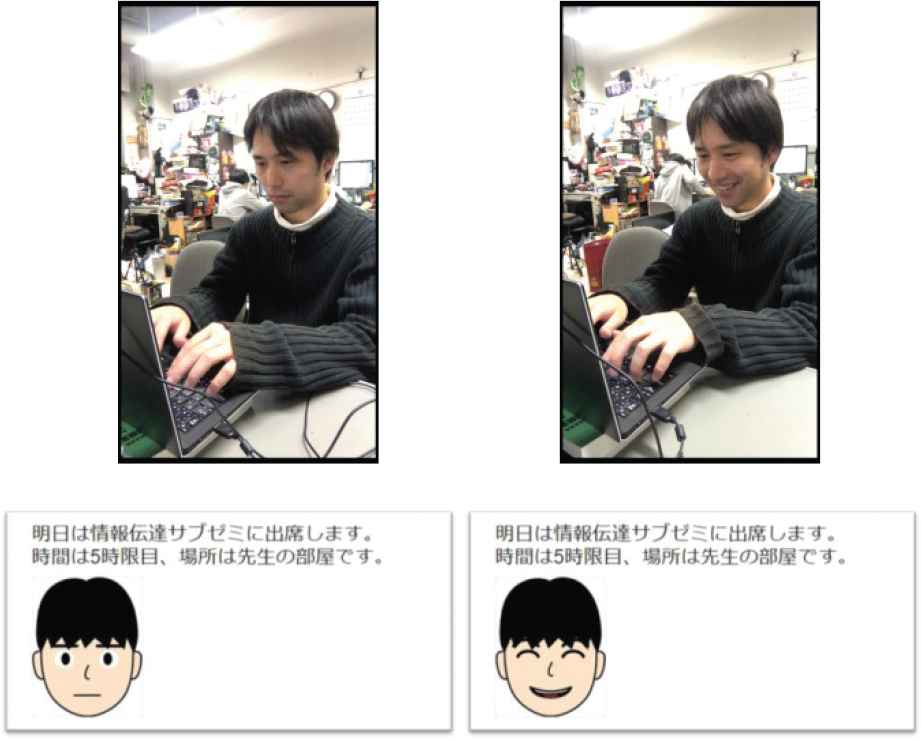
Snap-shots (upper) of posting on Twitter; messages and pictographs (lower) posted on Twitter (left: neutral; right: smiling) [8].
The results of the questionnaire surveys show that our system distinguished correctly between the two types (neutral and smiling) of facial expressions for the subject, and that the pictographs selected by the system correctly reflected the facial expressions while writing messages for the subject [8].
4. HUMAN–COMPUTER COMMUNICATION
4.1. Personified Agent
The process of agent generation in our system [10] consists of six steps: (1) creating facial expression data, (2) recording vocal utterances, (3) automatic WAVE file division, (4) speech recognition by Julius [11], (5) insertion of expressionless data, and (6) the creation of facial expression motion.
Expressive motions are generated by combining the expression data of each vowel for each utterance motion. Then, the utterance contents are input as text and used by the MikuMikuDanceAgent (MMDAgent) [12], which is a freeware animation program that allows users to create and animate movies with agents, to output synthesized voice that is then recorded by a stereo mixer inside a PC and saved as a WAVE file. Speech is recognized using a speech recognition system called Julius [11], followed by facial expression synthesis of the agent using preset parameters depending on each vowel. Facial expression data were created with MikuMikuDance [13].
In this study, to generate more human-like agent facial expressions, facial expression data were created for the vowels / a /, / i /, / u /, / e /, and / o / (Figure 4) [10]. To create more natural agent facial expressions, processing is then performed to insert a neutral facial expression when the same vowel, for example / a /, is continuous [10].

Facial expression of the agent when uttering each vowel [10].
4.2. Human–Computer Communication in Music Recommendation
The music recommendation module of the proposed system [14] is based on a previously proposed system [15] that uses collaborative filtering and impression words (see the paper [15] for details of the music recommendation module).
In the music-recommendation process, all user navigations are performed by the synthetic voice of the agent appearing on the PC screen facing the user. All dialogue spoken by the agent is situationally selected by the proposed system [14]. The user’s answers to the questions generated by the agent are recognized using the voice recognition function of the system, and the agent motions, including facial expressions, are then generated.
Figure 5 shows two snapshots of the reaction of the agent after recognizing (a) a positive answer, i.e., the user wishes to listen to the recommended song again in the future, and (b) a negative answer, i.e., the user does not wish to listen to the recommended song in the future. In the case of (a), the agent nods twice and raises the corners of the mouth slightly, while in the case of (b), the agent also nods twice, but lowers the corners of the mouth slightly. Figure 6 shows a snapshot of the music recommendation being performed by the proposed system [14].
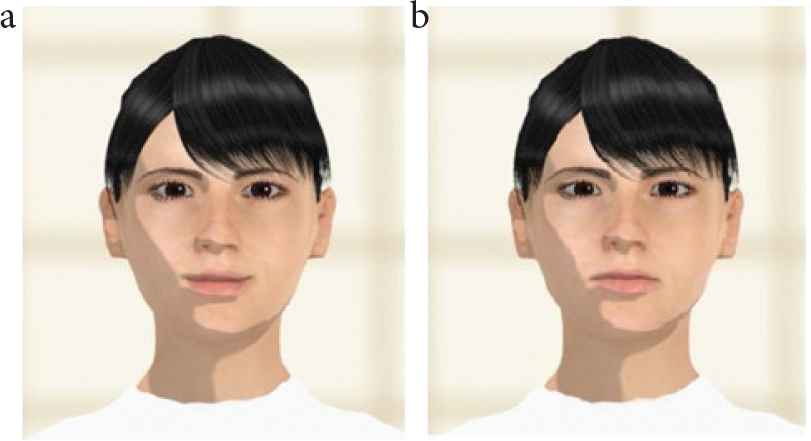
Snapshots of the reaction of the agent after recognizing (a) a positive answer and (b) a negative answer [14].
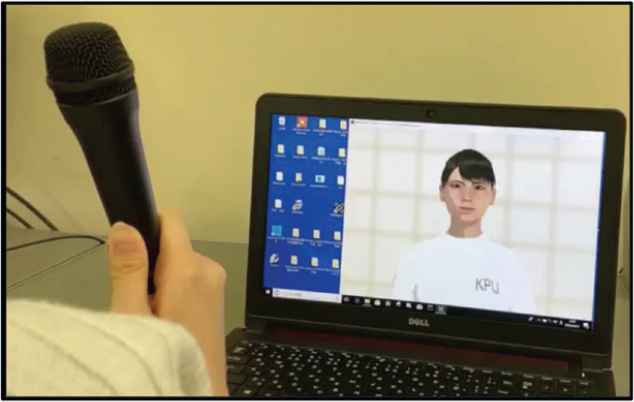
Snapshot of performing song-recommendation by the proposed system [14].
The experiment was performed separately using the database consisting of the 52 children’s songs, and that consisting of the 58 popular songs, with two experimental conditions for each (Condition 1: with the input to the system being performed by a supporter instead of the agent navigating the system and Condition 2: with the agent navigating the proposed system) [14]. Following the experiment, all subjects were requested to select one of five [evaluation value] answers ([5] absolutely yes, [4] yes, [3] I can’t say either, [2] no, [1] absolutely no) to seven questions (Table 1) to evaluate the proposed system [14]. Table 2 shows the average-values for each question listed in Table 1. The mean value of the averages listed in Table 2 was 4.1, suggesting a positive overall evaluation of the proposed system [14].
| No. | Question |
|---|---|
| 1 | Was music-recommendation on Condition 2 smoother than that on Condition 1? |
| 2 | Were explanations by the agent easy to understand? |
| 3 | Were dialogues with the agent natural? |
| 4 | Were movements of agent mouth natural? |
| 5 | Were agent’s reactions natural after recognizing user’s positive answer for listening to the just recommended music again in the future? |
| 6 | Were agent’s reactions natural after recognizing user’s negative answer of no more he just recommended music from now on? |
| 7 | Did you feel enjoyable in using the proposed system? |
Questionnaire to evaluate the proposed system [14].
| Question no. | 1 | 2 | 3 | 4 | 5 | 6 | 7 |
|---|---|---|---|---|---|---|---|
| Average | 3.6 | 4.4 | 4.0 | 3.6 | 4.5 | 4.3 | 4.5 |
Evaluation of the proposed system [14]
5. INTEGRATION WITH SPEECH
Utterance judgment is necessary for deciding the timing of facial expression recognition. Moreover, the mouth shape with or without an utterance influences facial expression. In our studies, the first and last vowels in an utterance such as a name were recognized for deciding the timing of the facial expression recognition [16,17].
Speech recognition and synthesis are indispensable for human-computer communication. In particular, developing the function of emotional speech synthesis [18] offers a way to create a paradigm whereby a computer system such as a robot can work seamlessly with humans.
6. CONCLUSION
To develop a complex computer system such as a robot that can communicate smoothly with humans, it is necessary to equip the system with the ability to both understand human emotion and express emotional signals to humans. From both points of view, facial expression is a promising research field. In developing a method for recognizing facial expressions, we have used infrared-ray images as well as visible-ray images. For expressing emotional signals to humans, we have developed a personified agent. Developing the function of emotional speech synthesis is the next target of our studies.
CONFLICTS OF INTEREST
The author declares no conflicts of interest.
ACKNOWLEDGMENTS
We would like to thank Dr. J. Narumoto, Professor of the Kyoto Prefectural University of Medicine, Dr. M. Tabuse, Professor of the Kyoto Prefectural University, and Dr. T. Asada, Associate Professor of the Kyoto Prefectural University, for their valuable cooperation during the course of this research.
AUTHOR INTRODUCTION
Dr. Yasunari Yoshitomi
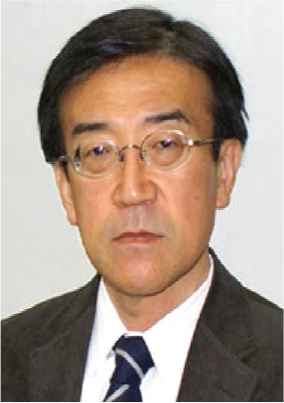 He received his B.E., M.E., and PhD degrees from Kyoto University in 1980, 1982, and 1991, respectively. He works as a Professor at the Graduate School of Life and Environmental Sciences of Kyoto Prefectural University. His specialties are applied mathematics and physics, informatics environment, intelligent informatics. He is a member of IEEE, HIS, ORSJ, IPSJ, IEICE, SSJ, JMTA, and IIEEJ.
He received his B.E., M.E., and PhD degrees from Kyoto University in 1980, 1982, and 1991, respectively. He works as a Professor at the Graduate School of Life and Environmental Sciences of Kyoto Prefectural University. His specialties are applied mathematics and physics, informatics environment, intelligent informatics. He is a member of IEEE, HIS, ORSJ, IPSJ, IEICE, SSJ, JMTA, and IIEEJ.
REFERENCES
Cite this article
TY - JOUR AU - Yasunari Yoshitomi PY - 2021 DA - 2021/05/27 TI - Human–Computer Communication Using Recognition and Synthesis of Facial Expression JO - Journal of Robotics, Networking and Artificial Life SP - 10 EP - 13 VL - 8 IS - 1 SN - 2352-6386 UR - https://doi.org/10.2991/jrnal.k.210521.003 DO - 10.2991/jrnal.k.210521.003 ID - Yoshitomi2021 ER -
